
Original Link: https://www.anandtech.com/show/2935
AMD’s Radeon HD 5570: Low Profile, Higher Performance
by Ryan Smith on February 9, 2010 12:00 AM EST- Posted in
- GPUs
When AMD launched the 5670, they told us they had 2 more cards on the way: the 5450, and a 5500 series card. Last week we saw the launch of the 5450, utilizing the Cedar GPU and finishing off AMD’s chip stack. Today we’re looking at that 5500 series card, the Radeon HD 5570.
| AMD Radeon HD 5670 | AMD Radeon HD 5570 | AMD Radeon HD 4670 | AMD Radeon HD 5450 | AMD Radeon HD 4550 | |
| Stream Processors | 400 | 400 | 320 | 80 | 80 |
| Texture Units | 20 | 20 | 32 | 8 | 8 |
| ROPs | 8 | 8 | 8 | 4 | 4 |
| Core Clock | 775MHz | 650 | 750MHz | 650MHz | 650MHz |
| Memory Clock | 1000MHz (4000MHz data rate) GDDR5 | 900MHz (1800MHz data rate) DDR3 | 1000MHz (2000MHz data rate) GDDR3 | 800MHz (1600MHz data rate) DDR3 | 800MHz (1600MHz data rate) DDR3 |
| Memory Bus Width | 128-bit | 128-bit | 128-bit | 64-bit | 64-bit |
| Frame Buffer | 1GB / 512MB | 1GB | 1GB / 512MB | 1GB / 512MB | 1GB / 512MB |
| Transistor Count | 627M | 627M | 514M | 292M | 242M |
| TDP | 61W | 42.7W | 59W | 19.1W | 25W |
| Manufacturing Process | TSMC 40nm | TSMC 40nm | TSMC 55nm | TSMC 40nm | TSMC 55nm |
| Price Point | $99 / $119 | $80-$85 | $60-$90 | $49-$59 | $35-$55 |
Right off the bat, the 5570 marks a bit of a departure from AMD’s numbering scheme for the 4000 series. While the Radeon HD 4550 was the faster of the two cards utilizing AMD’s cheapest GPU (RV710), the 5570 is not a faster Cedar card. Instead it’s a slower Redwood card, putting it in the ballpark of the 5670’s rather than the 5450’s.
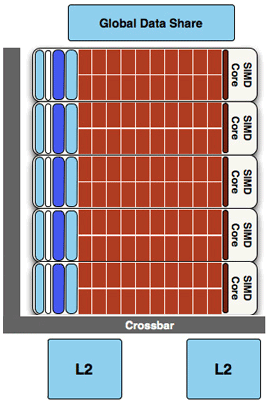
AMD has done 3 things to differentiate the 5570 from the 5670. The first of which is to significantly castrate the 5670’s memory bandwidth. While the 5670 had 1GHz (4GHz effective) GDD5, the 5570 drops that for simple 900MHz (1.8GHz effective) DDR3, giving the card only 45% of the memory bandwidth of the 5670. The second change is more customary, and that is lowering the core clock from 775MHz to 650MHz, leaving the card with roughly 83% of the computational/rendering/texturing performance of the 5670. None of the SIMDs have been disabled however, so this is a fully functional Redwood GPU.
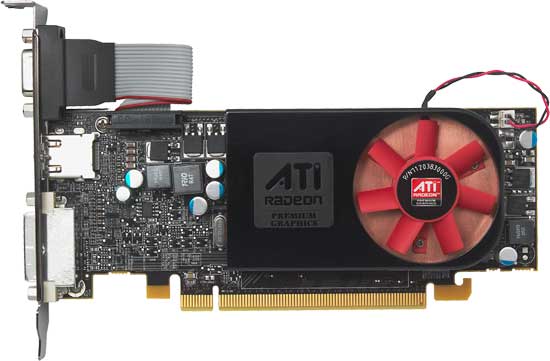
Finally, in another significant departure from the 4000 series, this is AMD’s second official low-profile video card. For the 4000 series AMD’s only official low-profile card was the 4350, although vendors were known to do low-profile versions of the 4550 (RV710) and the 4650 (RV730). Here AMD is not leaving that up to their vendors, and is doing an official retail low-profile design for their more powerful Redwood GPU. This allows AMD to fill a potential hole in their lineup by offering a low-profile GPU with better than bargain-bin performance.
This card also fills the overall price/performance hole in AMD’s 5000 series lineup, giving them something between the $9 9 5670 and the $50-$60 5450. AMD’s MSRP on this card will be $85, a bit more than half way between the other two cards. Unlike the 5670 and 5450, we’ll only be seeing a single official configuration of the 5570: 1GB of 900MHz DDR3. Our sample comes with 900MHz Samsung chips. It’s also worth noting that this is the same memory configuration as the base Radeon HD 4670, which also used 1GB of 900MHz DDR3.
Between the drop in the core clock and the movement to DDR3, AMD has lopped off nearly 30W from the 5670’s load power usage, bringing the 5570 in at 42.7W. Idle power also drops by nearly 33%, for 9.7W. This low power usage is a big part of why AMD can get away with the 5570 being a low-profile card, as they only need a small single-slot blower to cool the card. The reference cooler (not that we expect many – if any – vendors to use it) is a blower design built upon a copper heatsink, with a small fan blowing air towards the front of the card.
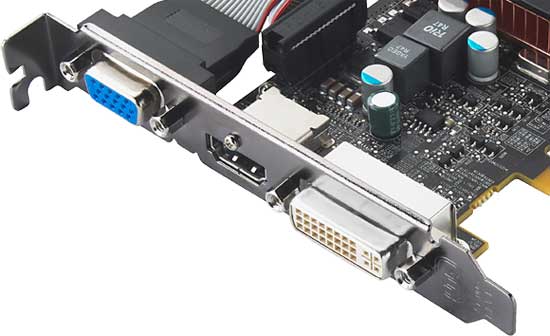
The port configuration is the same as the 5450: 1 VGA, 1 DVI, and 1 smaller digital port. Our sample came with a HDMI port, with vendors free to use an HDMI port or a DisplayPort depending on whether they want Eyefinity support as enabled by using a DisplayPort. As has been the case with all of AMD’s sub-$100 5000 series cards, Eyefinity is still cost-prohibitive at this time due to a lack of cheap active DisplayPort adaptors and monitors offering DisplayPort inputs.
AMD considers NVIDIA’s GT 220 the chief competition for this card. The GT 220 isn’t an official low-profile card, but there are a few models out there in that form factor. In terms of overall pricing, a number of GDDR5 GT 240s can be found at or right below $85, making the GT 240 the closest competitor for this card.
Meet Sapphire’s 5570
Sapphire also sent along their 5570. As a launch-day card it’s nearly identical to our reference card, utilizing the same PCB and RAM as that card. The only difference on the board itself is that our Sapphire card is equipped with a DisplayPort rather than an HDMI port.
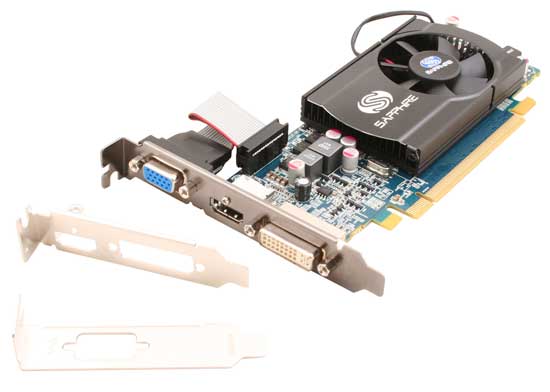
The bigger difference is that like virtually everyone else, Sapphire has ditched the reference cooler for another design. It’s still a single-slot cooler, but instead of AMD’s blower Sapphire is using an open-ended design that vents air out the front and the rear. It’s painted black so we can’t tell what material it’s made from, but we suspect it’s aluminum rather than copper like AMD’s. This will be worth keeping in mind for later when we look at the cooling characteristics of these two cards.
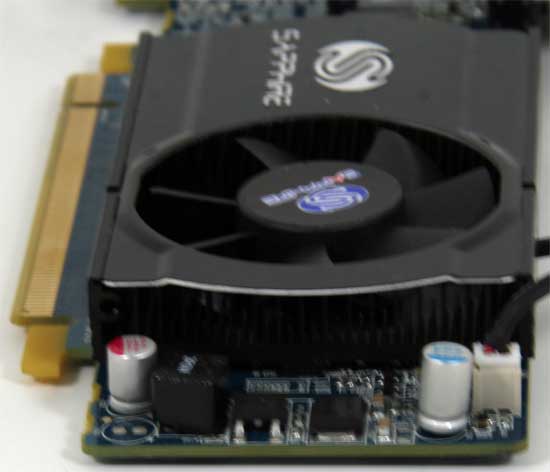
As with Sapphire’s 5450, their 5770 comes in a surprisingly large box. Inside is the card, a low-profile bracket, drivers, an installation guide, and Arcsoft’s SimHD video conferencing plugin.
Still Not the Perfect HTPC Card
After encountering the video decoding limitations of the 5450 in our review of that card, we had been expecting the 5570 to finally fill the role of the perfect HTPC card. Since we had already seen that the 5670 had full video acceleration capabilities under any circumstance, it wouldn’t be much of a stretch for the 5570 to deliver a repeat performance.
Unfortunately that hasn’t come to pass, in fact if anything its proven the 5450 isn’t quite as good of an HTPC card as we first thought.
But before we get ahead of ourselves, let’s start with what’s been a wrench in our plans the entire time: the Enforce Smooth Video Playback option in AMD’s drivers. ESVP is an option in AMD’s drivers that does exactly what it says on the box: it ensures that any videos playing through AMD’s UVD2 decoder play back smoothly. After talking to AMD we’ve come to understand that this is a quality of service mechanism, with there apparently being a couple of different factors involved. The biggest factor as far as the video card is concerned is that when ESVP is enabled, it allows the drives to disable any post-processing features they believe might impact the playback performance of the card.
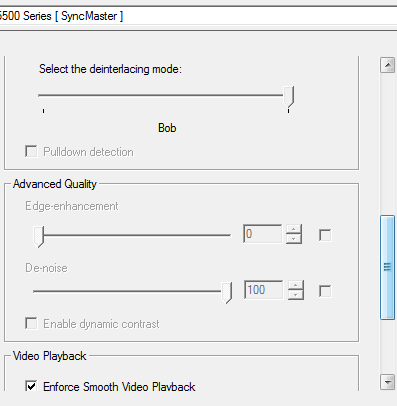
The AVIVO control panel on the Radeon HD 5570
We’re still going back and forth with AMD trying to get the full details on how ESVP works, but from what we understand thus far and what we’re seeing in the Catalyst Control Center, it looks like AMD is hardcoding their drivers to disable certain post-processing features when ESVP is enabled, depending on the hardware being used. In the case of the 5570, virtually all post-processing features are disabled when ESVP is enabled, with the only remaining options being to select between Bob and Weave deinterlacing.
This actually made us reexamine our 5450, since it didn’t disable so many features when ESVP is enabled. As it turns out that’s a bug in the current version of the drivers for the 5450, and in spite of what the Catalyst Control Center is showing, the 5450 cannot use any additional post-processing features beyond what the 5570 can use, meaning that Edge Enhancement and De-Noise don’t actually work on the 5450 when ESVP is enabled.
As a result, the 5570 does no better on the Cheese Slices video test than the 5450. With ESVP enabled, it can’t do Vector Adaptive Deinterlacing to correct jagged lines on things such as sports fields. It’s still a small issue, but it stands in the way of HTPC perfection.
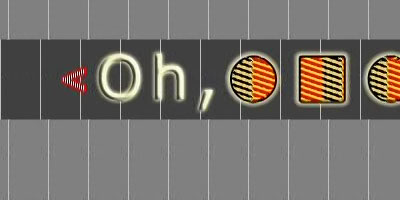
Cheese Slices:
Radeon 5670 Deinterlacing
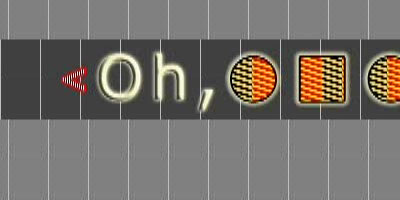
Cheese Slices:
Radeon 5570 Deinterlacing
Ultimately the 5450 and 5570 are both limited-functionality cards for HTPC use, giving users the choice between video playback QoS and post-processing. In our testing we didn’t notice any obvious playback issues with the 5450 or 5570 when we had ESVP disabled, but we’ve seen enough forum posts of this feature magically fixing poor video playback performance that we’re not confident enough to recommend disabling this feature. It’s something we think should be left enabled, at least for the time being.
This makes the 5670 the most-perfect HTPC card, as we’ve found it to be able to offer all of AMD’s post-processing features with ESVP enabled, and of course it offers audio bitstreaming like the rest of the 5000 series. The downside to this is that the 5670 is $99, it isn’t low-profile, and at 70W TDP it’s not a particularly cool card. It’s certainly more than workable as an HTPC card, but until someone can get a 5670 out there that’s passively cooled, it’s not the ideal HTPC card that enthusiasts have been looking for.
We’ll also quickly add to this that this all depends on AMD’s drivers, rather than the hardware. Certainly AMD can tweak things if they determine that the 5570 has enough power to do more post-processing, but obviously there’s no guarantee that will happen.
The Test
For the 5570 launch, we’re using the same drivers as the 5450 launch: 8.69RC3.
| CPU: | Intel Core i7-920 @ 3.33GHz |
| Motherboard: | Intel DX58SO (Intel X58) |
| Chipset Drivers: | Intel 9.1.1.1015 (Intel) |
| Hard Disk: | Intel X25-M SSD (80GB) |
| Memory: | Patriot Viper DDR3-1333 3 x 2GB (7-7-7-20) |
| Video Cards: |
AMD Radeon HD 5970 AMD Radeon HD 5870 AMD Radeon HD 5850 AMD Radeon HD 5770 AMD Radeon HD 5750 AMD Radeon HD 5670 512MB AMD Radeon HD 5570 1GB AMD Radeon HD 5450 512MB AMD Radeon HD 4890 AMD Radeon HD 4870 1GB AMD Radeon HD 4850 AMD Radeon HD 3870 AMD Radeon HD 4770 AMD Radeon HD 4670 512MB AMD Radeon HD 4550 512MB NVIDIA GeForce GTX 295 NVIDIA GeForce GTX 285 NVIDIA GeForce GTX 275 NVIDIA GeForce GTX 260 Core 216 NVIDIA GeForce GTS 250 NVIDIA GeForce 8800 GT NVIDIA GeForce 9600 GT NVIDIA GeForce GT 240 NVIDIA GeForce GT 220 NVIDIA GeForce 210 |
| Video Drivers: |
NVIDIA ForceWare 190.62 NVIDIA ForceWare 195.62 AMD Catalyst Beta 8.66 AMD Catalyst Beta 8.66.6 AMD Catalyst 9.9 AMD Catalyst Beta 8.69 |
| OS: | Windows 7 Ultimate 64-bit |
Crysis: Warhead
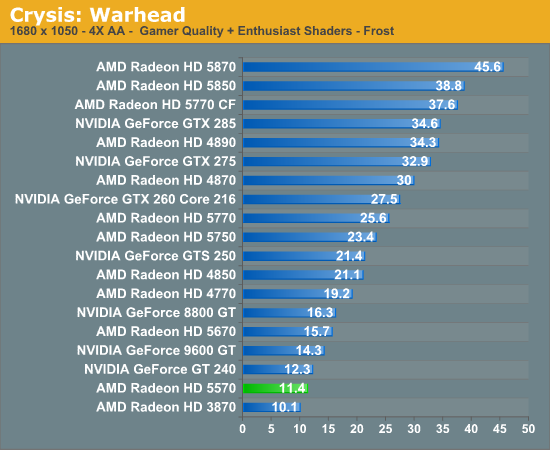
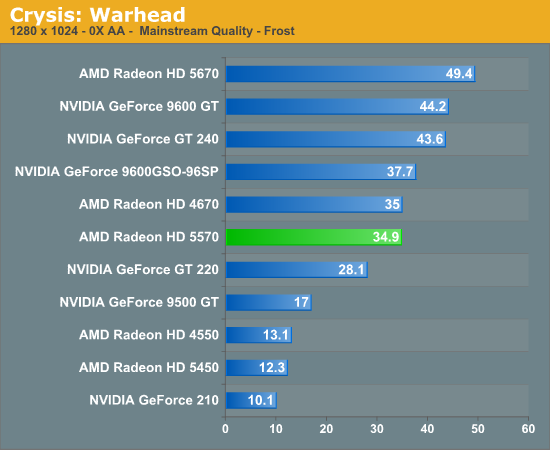
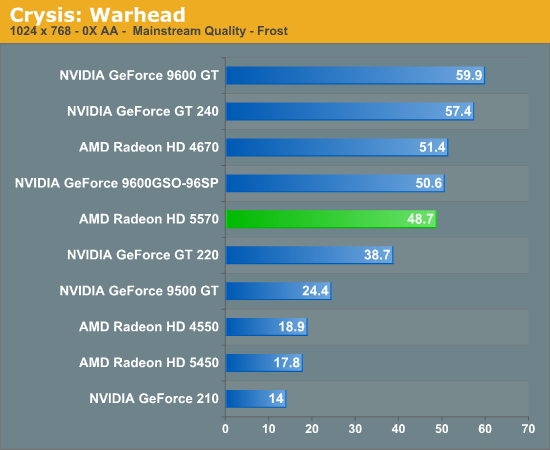
The loss of memory bandwidth becomes immediately apparent in Crysis, where the 5570 underperforms the full 5670 by around 30%. This moves 1280 from being a fully playable resolution to a borderline playable resolution, and will be a common thread when comparing these cards.
On the other hand the 5570 is nearly 3x faster than the 5450, which just goes to show you what another $25 will buy you in terms of performance over such a bottom-tier card.
For the competition, the cards to watch out for will be the Radeon 4670, the GeForce GT 240, and the GeForce 9600GT, all of which are priced similar if not lower, and outperform the 5570.
Far Cry 2
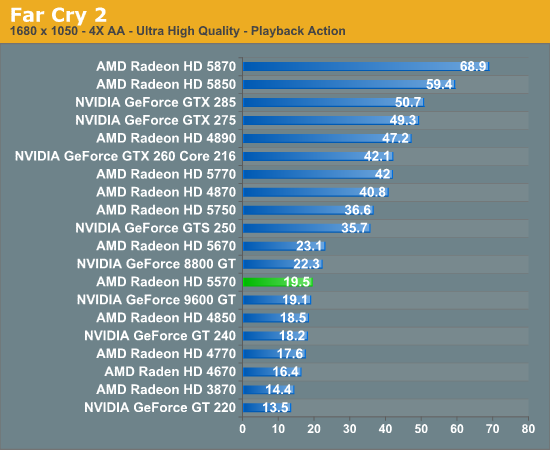
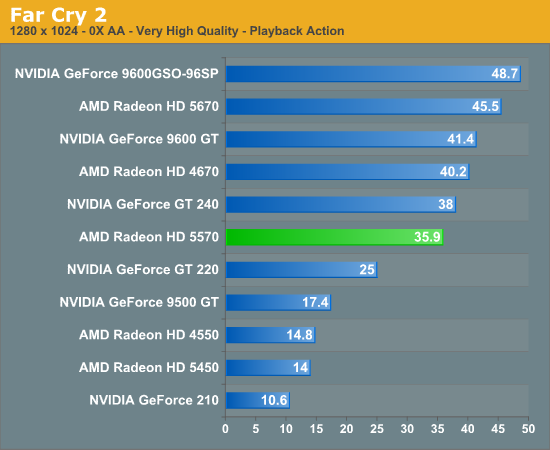
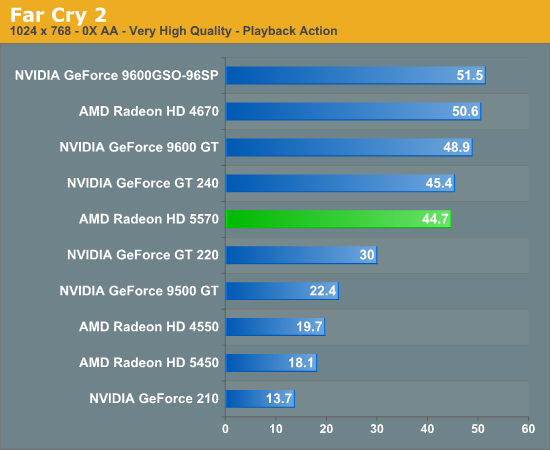
The overall order is similar to Crysis, but the performance loss isn’t quite as severe. Moving form a 5670 to a 5570 brings with it an up to 22% performance drop in Far Cry 2, although this is still enough to drive 1280 down to a borderline playable framerate.
As for the competition, the 4670, GT 240, and 9600GT all continue to be ahead by varying degrees, particularly at 1280 and 1024. The 9600GT enjoys the largest lead, with the 5570 behind by 15%.
Battleforge
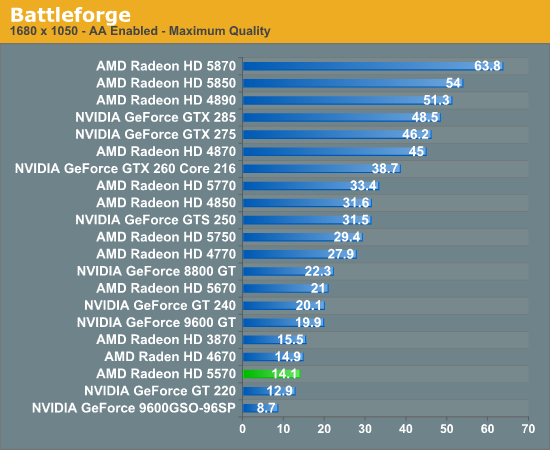
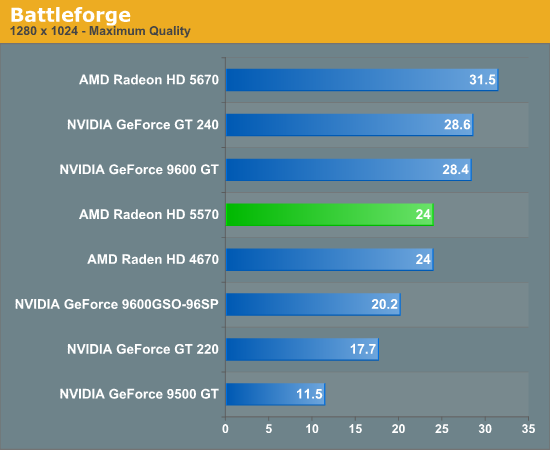
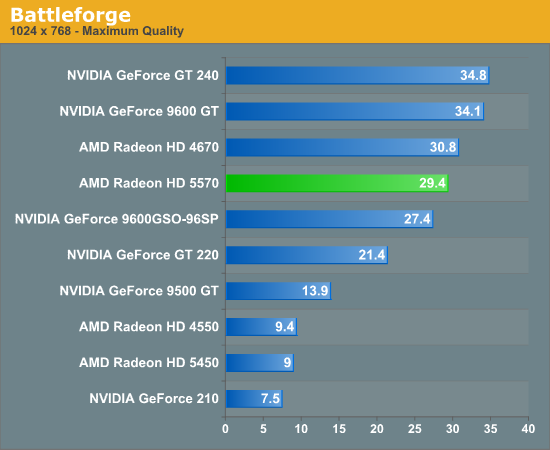
RTSes may have a lower playability threshold than action games, but for the 5570 at max quality, only 1024 is close to that threshold. This is once again basically giving up a level of resolution compared to the 5670, as the 5570 is roughly 25% slower.
The 5570 does get its first tie with the 4670 here, while the GT 240 and 9600GT are around 20% faster.
HAWX
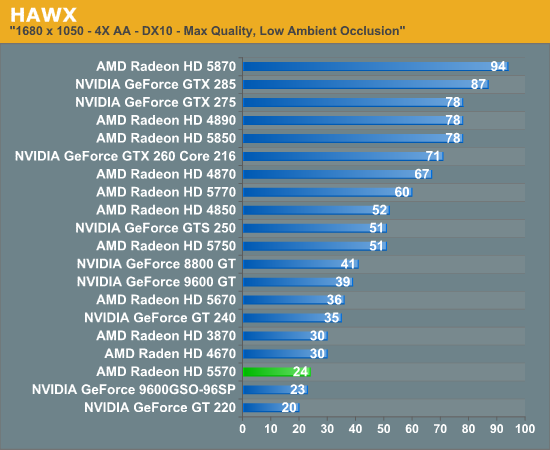
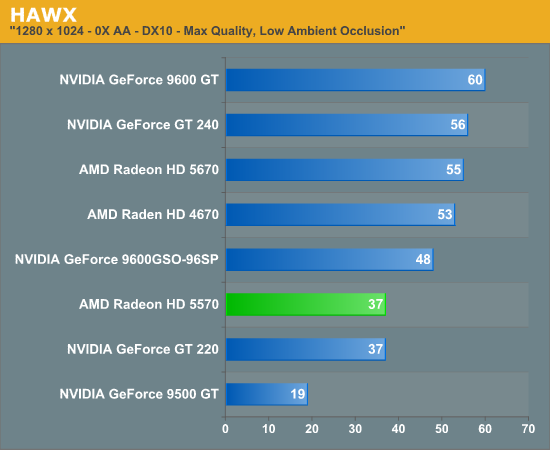
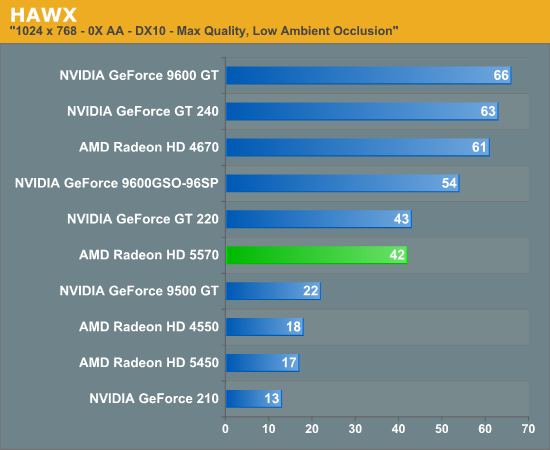
Once again we have to drop a resolution as compared to the 5670 to break 30fps. HAWX hits the 5570’s limited memory bandwidth harder than everything that has come before, dropping around 35% in performance as compared to the 5670.
This also means that the much more bandwidth saturated GT 240 and 9600GT do exceptionally well here, the latter outperforming the 5570 by an astonishing 62%.
Dawn of War II
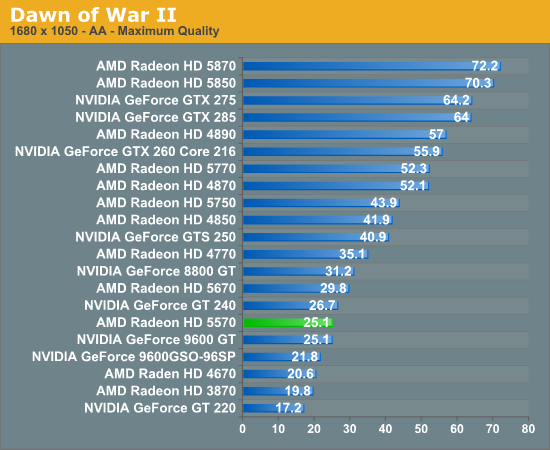
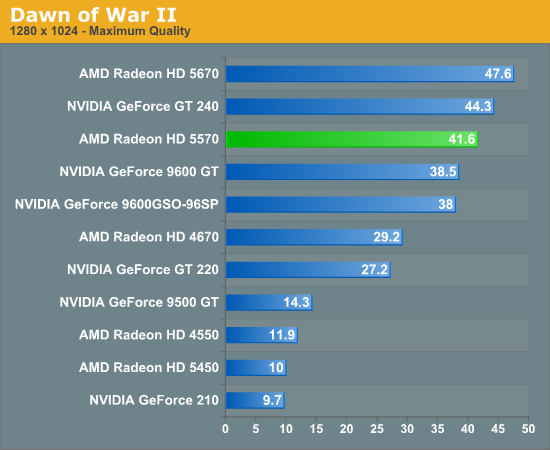
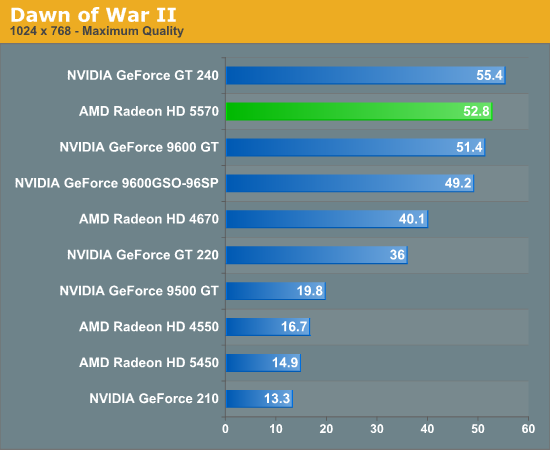
Dawn of War II on the other hand is much less sensitive to memory bandwidth than HAWX. Here the performance gap between the 5570 and the 5670 is almost perfectly in line with the difference in core speed between the two cards, with the 5570 being roughly 16% slower. In terms of the highest playable resolution however, the 5670 was marginal enough that you still basically have to drop a resolution for the 5570.
As for the competition, the 5570 does exceptionally well here compared to the 4670 and the 9600GT. Only the GT 240 is consistently faster, if only by 6%.
Resident Evil 5
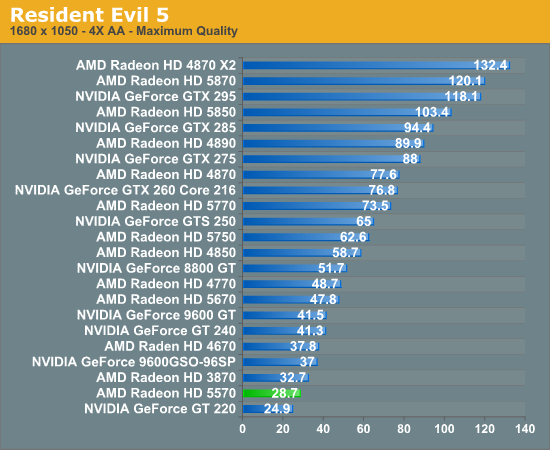
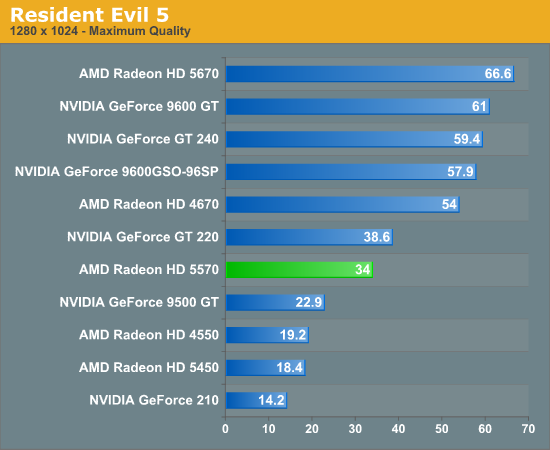
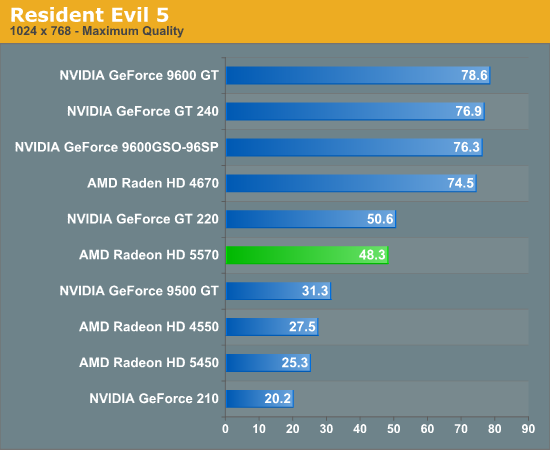
Resident Evil is another game that the 5570 gets hit hard by, basically only offering 50% of the performance of the 5670, roughly in line with their memory bandwidth differences. Where 1680 was smooth on the 5670, 1280 is borderline on the 5570, and 1024 is the only real smooth resolution for maximum quality settings.
This also means that the competition once again does well. The 4670, GT 240, and 9600GT are all well ahead, this time the 9600GT is ahead by an awesome 80% at 1280.
Batman: Arkham Asylum
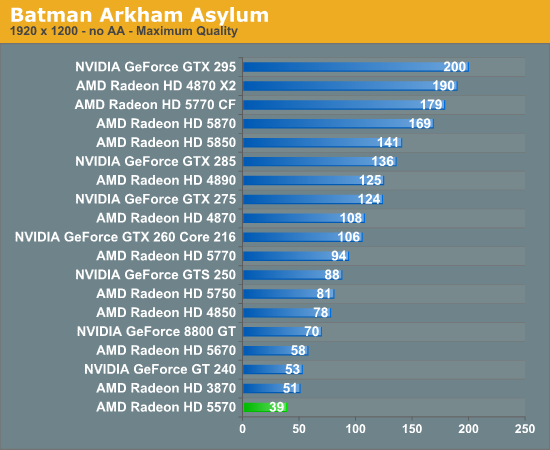
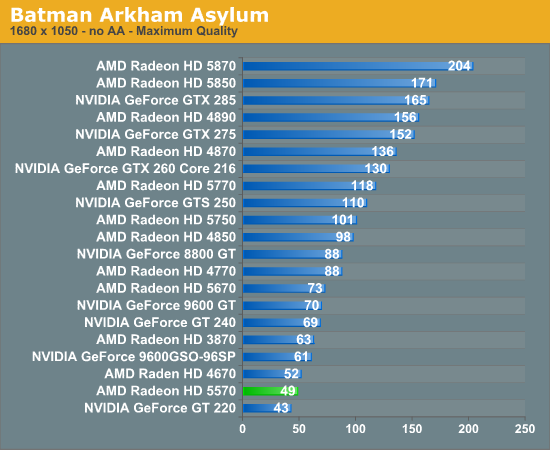
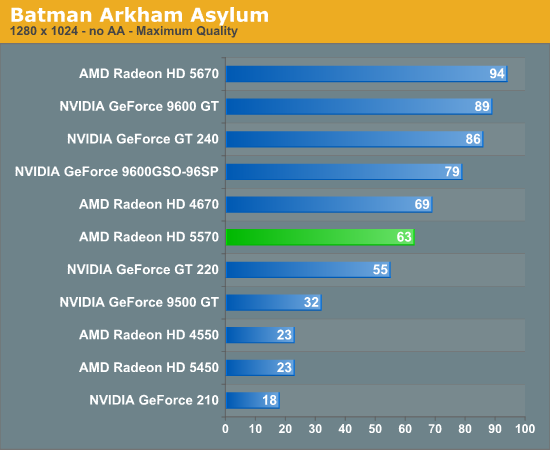
Batman: Arkham Asylum is the first game where the 5570 has a fighting chance at 1920. For 39fps it’s not as smooth as it could be, but it’s playable. Moving down to 1680 gets us a fully playable framerate, and makes for one of the few games where the 5570 is playable at that resolution. Of course the 5670 got a better framerate at a higher resolution, or for 1680 we’re looking at the 5570 underperforming by around 33%.
This is also another game that rewards memory bandwidth, putting the GT 240, 4670, and 9600GT ahead of the 5570.
Left 4 Dead
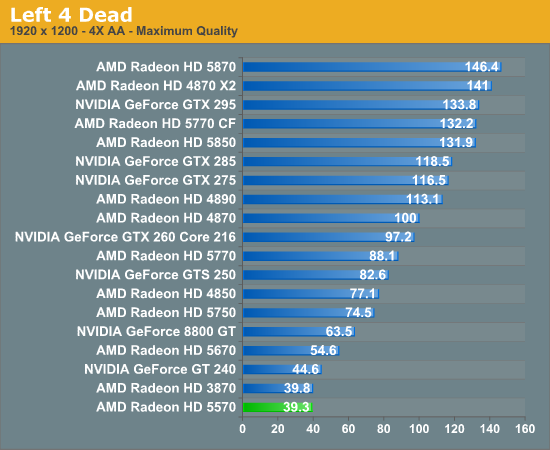
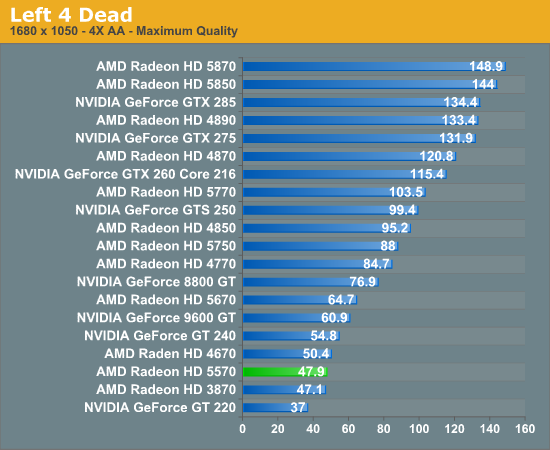
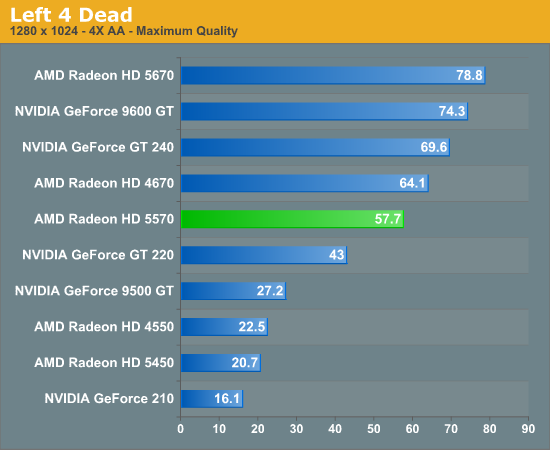
If by now you haven’t figured it out, older less shader-heavy games tend to bring out the biggest performance differences between the 5570 and other cards, with Left 4 Dead not being any different. 1920 with 4x anti-aliasing still gets almost 40fps, but it’s still 30% slower than the 5670. At 1680 the 9600GT is only 27% ahead however.
Power, Temperature, & Noise
As a note here, since NVIDIA does not offer a reference GT 240, we’re using our Asus 512MB GDDR5 GT 240 as our reference 240.
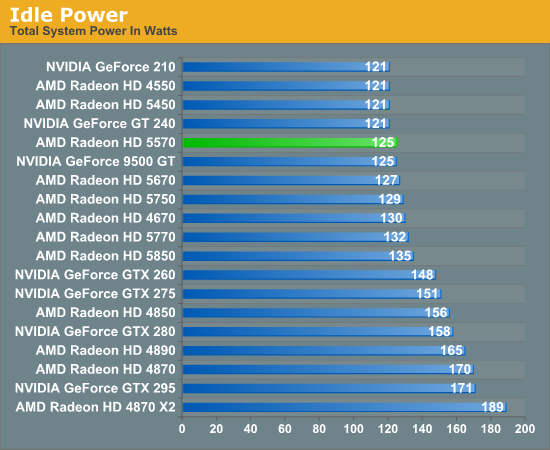
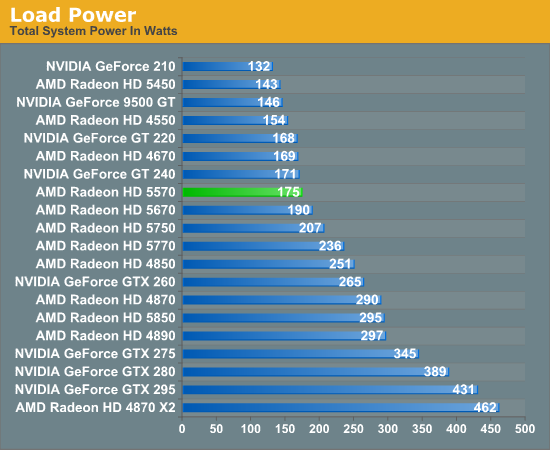
With a 42W TDP and 9.7W idle power rating, it should come as no surprise that the 5570 comes in between the 5450 and 5670 at both power measurements. The GT 240 is the biggest winner here, beating even the 5570. However this is likely due to differences in how AMD and NVIDIA throttle their cards under FurMark.
In terms of performance per watt, the 5570 falls in the same general range as the 4670 and the GT 240. This also gives us an idea of where the cut-off is for what can be done with a low-profile card – at 15W more under load, the 5670 basically marks the start of a whole new class of cards.
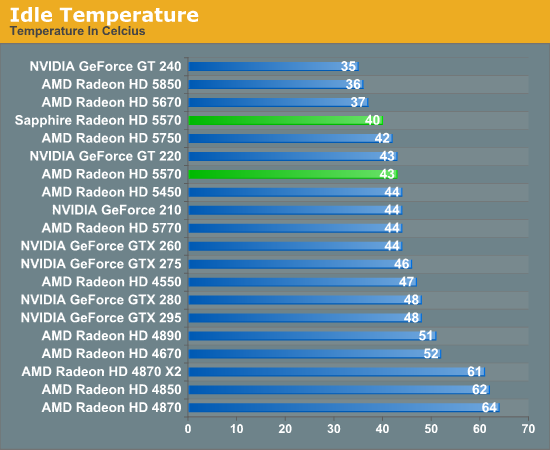
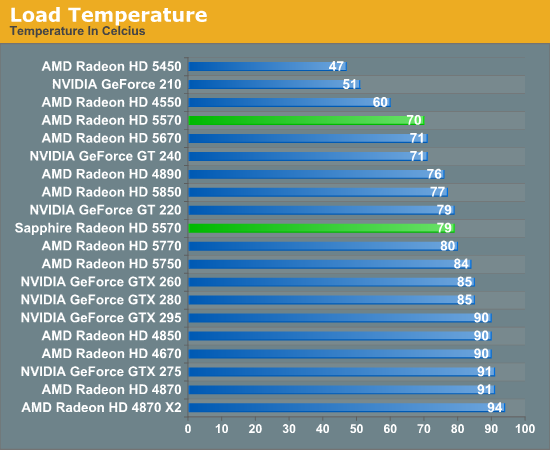
One thing you give up in moving to a smaller cooler for a low-profile card is the nice temperatures a full-profile card can attain. The 5570 ends up being several degrees warmer when idling when compared to the 5670, sharing company with our passive cards and some mid-range cards. Interestingly the Sapphire card does better here, coming in 3 degrees cooler at 40C.
Under load we have a different story. The 5570 marks a clear gap between passively cooled cards and actively cooled cards, but it enjoys the status of being our coolest actively cooled card. The Sapphire card on the other hand doesn’t do so well here, coming in at nearly 10C hotter. We believe that this is due to a combination of the difference in their fans and the use of a copper heatsink in the AMD reference card versus an aluminum heatsink in the Sapphire card. Unfortuantely we can’t tell which one has the bigger impact, since switching out a heatsink can improve the cooling performance without having an acoustic impact like switching out a fan does.
On a more speculative note, based particularly on the AMD card’s temperatures, the 5570 looks like a good candidate to get the passive treatment. It would likely need to be a full-sized card, but certainly it’s cool enough that someone should be able to build a passive Redwood card here.
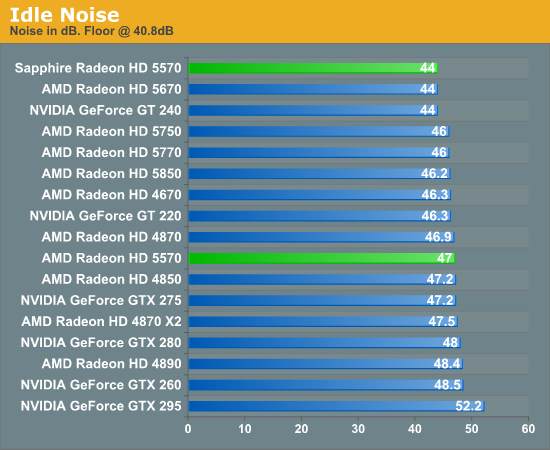
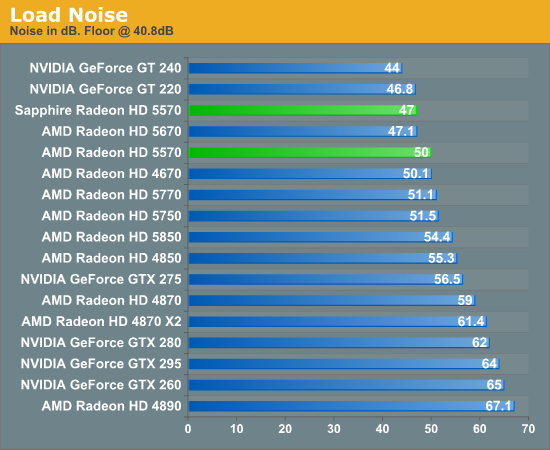
Despite the number of cards with small fans in our collection, the AMD 5570 stands out as having one of the loudest. Not only is it loud enough to do a bit worse at idle than a number of other cards (all of which tend to hug the noise floor), but it has just the right pitch to sound loud. We can easily tell it apart from all the other fans in our Spedo case, something that isn’t the case with several of these other cards. The fan on the Sapphire card on the other hand is as quiet as anything else we have tested when it comes to idling.
Under load the AMD card continues to be at a disadvantage. The more power-hungry cards end up being louder, but it’s still louder than the 4670 and even the 5670 (the latter of which is a surprisingly quiet card). The Sapphire on the other hand bests the 5670, but remember that the cost of this is that the Sapphire card hits nearly 80C under load. Sapphire’s card is clearly tuned for acoustics over thermals.
Conclusion
With AMD's positioning of the Radeon HD 5570 in the marketplace, you can get a few very different outcomes depending on what you’re looking for. As a video-only HTPC card, it’s no better than the 5450 in features, while it’s worse in terms of power consumption and noise. Based on our research the 5570 isn’t the HTPC über card we were expecting it to be, so if you can bear the limitations of the 5450, that’s going to be the better card. Otherwise the 5670 is the most capable choice out there. The 5570 does nothing better than either of those two cards when it comes to HTPC use.
Meanwhile if we take a look at overall performance, the 5570 doesn’t fare much better. The move from GDDR5 to DDR3 has a significant impact on the performance of the Redwood GPU in most cases, bringing the 5570 well below the 5670 and similar cards. The lower-end of the 5000 series has been consistently overpriced when it comes to overall performance, and the 5570 is no different. The GDDR3 9600GT can be found for around the same price point, and is anywhere between just as fast as the 5570 to completely clobbering it. The 5570 can’t compete amidst that much of a memory bandwidth gap. If you can fit a full-sized card, you can do much better than the 5570 when it comes solely to performance; the 9600GT and the GT 240 are both much more capable cards for the $80-$85 price tag.
Last, but certainly not least however, is the area the 5570 excels at: low-profile cards. The low-profile market is basically dominated by bottom-tier cards such as the GeForce 210, Radeon 4350, Radeon 5450, and of course a number of even older cards. The 5570 is faster than every single one of them, usually by a factor of 2-3x. Compared to the 5450 in particular, it fits in the same form factor and offers around 3x the performance for only $25 more. The use of Redwood as opposed to Cedar does mean it consumes more power and generates more heat, but this should be a bearable tradeoff for the significant performance improvement in most low-profile cases.
The only catch we would add to that is that while the 5570 is going to be the fastest mass-market card, technically speaking it’s not the fastest low-profile card ever made. We’ve seen a low-profile 9800GT from Sparkle that should make quick work of the 5570, but at 2x the power draw of the 5570, it’s a specialty card that would only work in a limited number of well ventilated low-profile cases. The 5570 in comparison is going to be the fastest low-profile card on mass-market.
With that out of the way however, there’s not a whole lot else we can say. By being a low-profile card the 5570 is a more compelling second-tier card to the 5670 than the 4650 was to the 4670, but otherwise it brings with it all the pitfalls of trying to shave down the price of an already decently cheap card. Unless you need a low-profile card or a card that specifically meets the 5570’s power characteristics, you’re going to be better off looking at other cards, particularly if you can swing a little more money for something like the Radeon 4850 while it’s still available.







